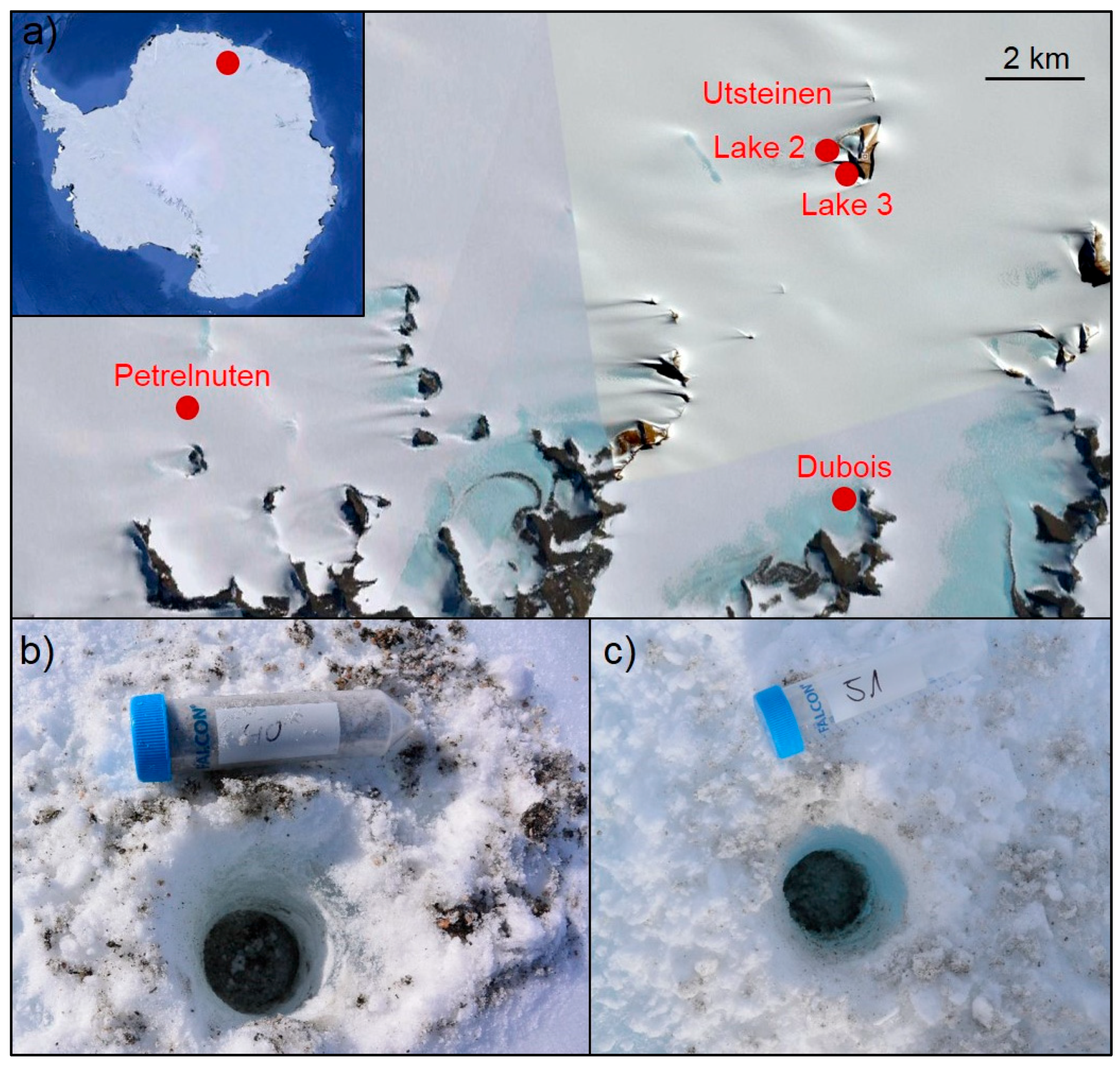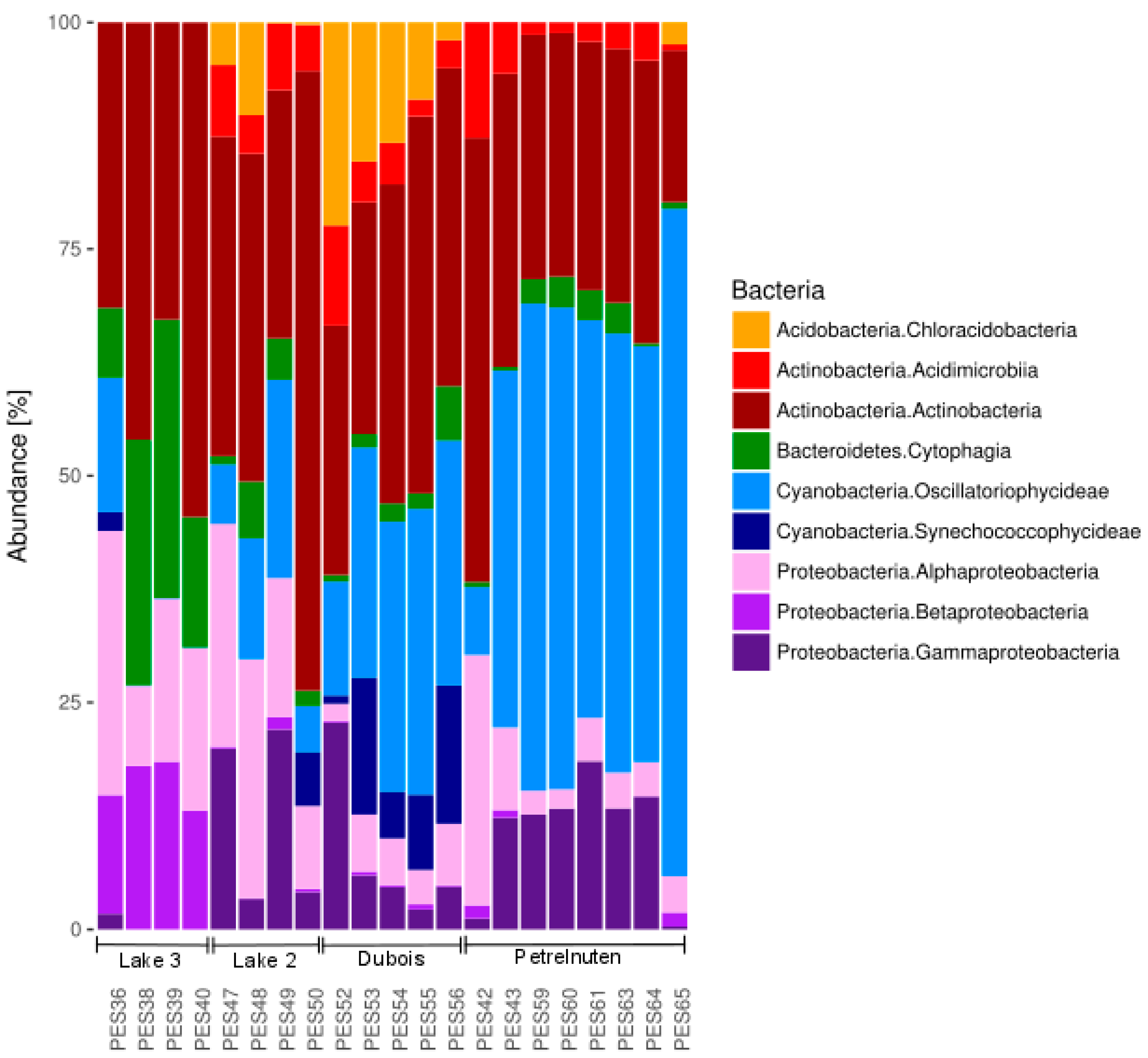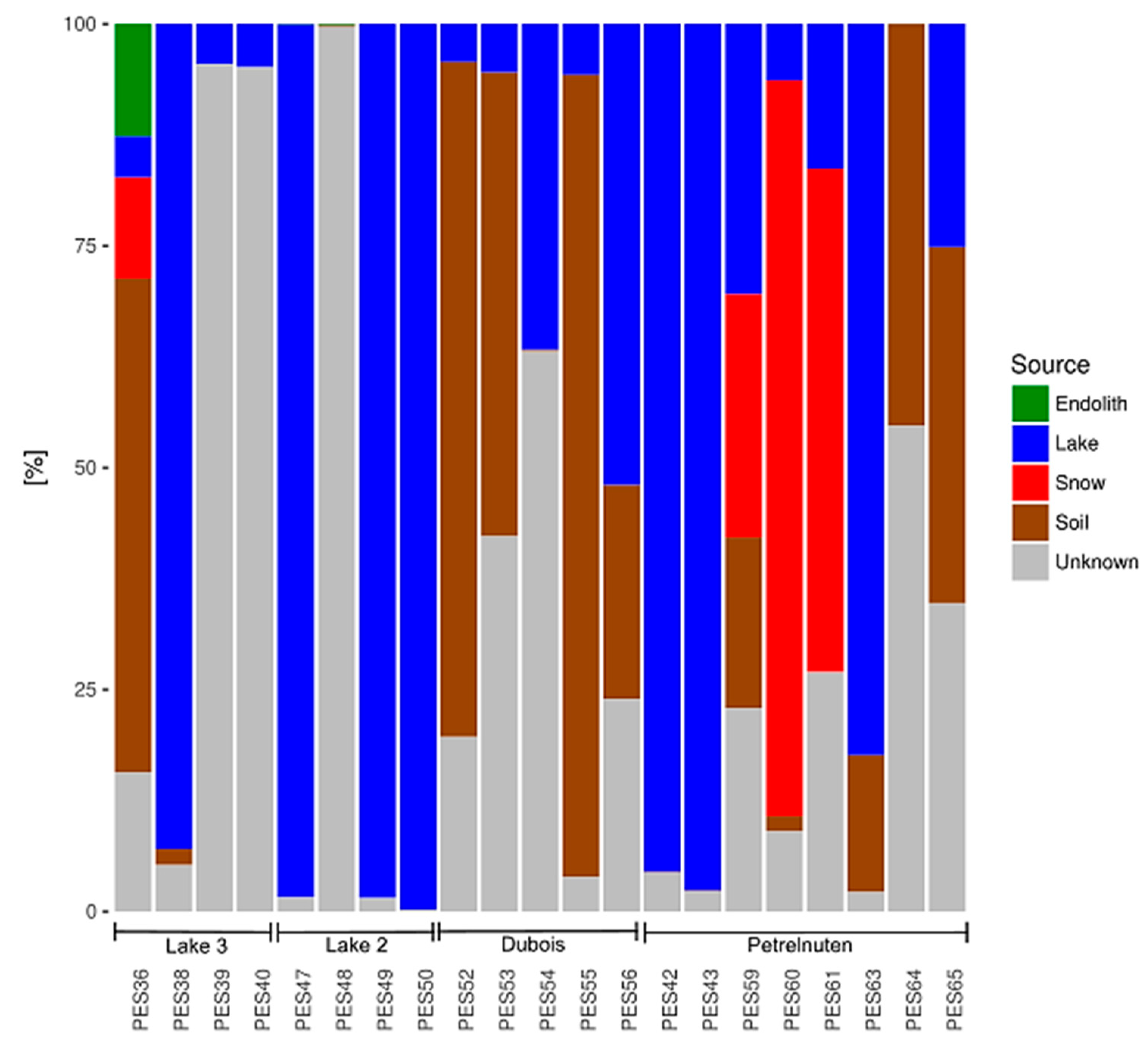The Biodiversity and Geochemistry of Cryoconite Holes in Queen Maud Land, East Antarctica
Abstract
:1. Introduction
2. Materials and Methods
2.1. Field Sites and Sampling
2.2. DNA Sequencing and Bioinformatics
2.3. Organic Geochemistry
2.4. Inorganic Geochemistry
2.5. Aqueous Geochemistry
2.6. Statistical Analyses
3. Results
3.1. Bacterial Community Composition
3.2. Eukaryotic Community Composition
3.3. Organic Geochemistry
3.4. Inorganic Geochemistry
3.5. Relationship Between Microbial Community Compositions and Geochemistry
4. Discussion
Supplementary Materials
Author Contributions
Funding
Acknowledgments
Conflicts of Interest
References
- Anesio, A.M.; Lutz, S.; Chrismas, N.A.M.; Benning, L.G. The microbiome of glaciers and ice sheets. NPJ Biofilms Microbiomes 2017, 3, 10. [Google Scholar] [CrossRef] [PubMed] [Green Version]
- Cook, J.; Edwards, A.; Takeuchi, N.; Irvine-Fynn, T. Cryoconite: The dark biological secret of the cryosphere. Prog. Phys. Geogr. 2016, 40, 66–111. [Google Scholar] [CrossRef]
- Kleinteich, J.; Hildebrand, F.; Bahram, M.; Voigt, A.Y.; Wood, S.A.; Jungblut, A.D.; Küpper, F.C.; Quesada, A.; Camacho, A.; Pearce, D.A.; et al. Pole-to-Pole Connections: Similarities between Arctic and Antarctic Microbiomes and Their Vulnerability to Environmental Change. Front. Ecol. Evol. 2017, 5, 137. [Google Scholar] [CrossRef]
- Christner, B.C.; Kvitko, B.H.; Reeve, J.N. Molecular identification of bacteria and eukarya inhabiting an Antarctic cryoconite hole. Extremophiles 2003, 7, 177–183. [Google Scholar] [CrossRef] [PubMed]
- Gokul, J.K.; Hodson, A.J.; Saetnan, E.R.; Irvine-Fynn, T.D.L.; Westall, P.J.; Detheridge, A.P.; Takeuchi, N.; Bussell, J.; Mur, L.A.J.; Edwards, A. Taxon interactions control the distributions of cryoconite bacteria colonizing a High Arctic ice cap. Mol. Ecol. 2016, 25, 3752–3767. [Google Scholar] [CrossRef] [PubMed] [Green Version]
- Anesio, A.M.; Hodson, A.J.; Fritz, A.; Psenner, R.; Sattler, B. High microbial activity on glaciers: Importance to the global carbon cycle. Glob. Chang. Biol. 2009, 15, 955–960. [Google Scholar] [CrossRef]
- Säwström, C.; Mumford, P.; Marshall, W.; Hodson, A.; Laybourn-Parry, J. The microbial communities and primary productivity of cryoconite holes in an Arctic glacier (Svalbard 79 N). Polar Biol. 2002, 25, 591–596. [Google Scholar]
- Telling, J.; Anesio, A.M.; Tranter, M.; Irvine-Fynn, T.; Hodson, A.; Butler, C.; Wadham, J. Nitrogen fixation on Arctic glaciers, Svalbard. J. Geophys. Res. 2011, 116, G03039. [Google Scholar] [CrossRef]
- Foreman, C.M.; Sattler, B.; Mikucki, J.A.; Porazinska, D.L.; Priscu, J.C. Metabolic activity and diversity of cryoconites in the Taylor Valley, Antarctica. J. Geophys. Res. 2007, 112, G04S32. [Google Scholar] [CrossRef]
- Fountain, A.G.; Tranter, M.; Nylen, T.H.; Lewis, K.J.; Mueller, D.R. Evolution of cryoconite holes and their contribution to meltwater runoff from glaciers in the McMurdo Dry Valleys, Antarctica. J. Glaciol. 2004, 50, 35–45. [Google Scholar] [CrossRef]
- McCrimmon, D.O.; Bizimis, M.; Holland, A.; Ziolkowski, L.A. Supraglacial microbes use young carbon and not aged cryoconite carbon. Org. Geochem. 2018, 118, 63–72. [Google Scholar] [CrossRef]
- Musilova, M.; Tranter, M.; Bamber, J.L.; Takeuchi, N.; Anesio, A.M. Experimental evidence that microbial activity lowers the albedo of glaciers. Geochem. Perspect. Lett 2016, 2, 106–116. [Google Scholar] [CrossRef]
- Takeuchi, N.; Kohshima, S.; Seko, K. Structure, formation, and darkening process of albedo-reducing material (cryoconite) on a Himalayan glacier: A granular algal mat growing on the glacier. Arctic. Antarct. Alp. Res. 2001, 33, 115–122. [Google Scholar] [CrossRef]
- Sommers, P.; Darcy, J.L.; Gendron, E.M.S.; Stanish, L.F.; Bagshaw, E.A.; Porazinska, D.L.; Schmidt, S.K. Diversity patterns of microbial eukaryotes mirror those of bacteria in Antarctic cryoconite holes. FEMS Microbiol. Ecol. 2018, 94, fix167. [Google Scholar] [CrossRef] [PubMed]
- Webster-Brown, J.G.; Hawes, I.; Jungblut, A.D.; Wood, S.A.; Christenson, H.K. The effects of entombment on water chemistry and bacterial assemblages in closed cryoconite holes on Antarctic glaciers. FEMS Microbiol. Ecol. 2015, 91, fiv144. [Google Scholar] [CrossRef] [Green Version]
- Obbels, D.; Verleyen, E.; Mano, M.-J.; Namsaraev, Z.; Sweetlove, M.; Tytgat, B.; Fernandez-Carazo, R.; De Wever, A.; D’hondt, S.; Josef Elster, D.E.; et al. Bacterial and eukaryotic biodiversity patterns in terrestrial and aquatic habitats in the Sør Rondane Mountains, Dronning Maud Land, East Antarctica. FEMS Microbiol. Ecol. 2016, 92, fiw041. [Google Scholar] [CrossRef]
- Tytgat, B.; Tytgat, B.; Verleyen, E.; Sweetlove, M.; D’hondt, S.; Clercx, P.; Van Ranst, E.; Karolien, P.; Peeters Roberts, S.; Namsaraev, Z.; et al. Bacterial community composition in relation to bedrock type and macrobiota in soils from the Sør Rondane Mountains, East Antarctica. FEMS Microbiol. Ecol. 2016, 92, fiw126. [Google Scholar] [CrossRef]
- Taton, A.; Grubisic, S.; Balthasart , P.; Hodgson, D.A.; Laybourn-Parry, J.; Wilmotte, A. Biogeographical distribution and ecological ranges of benthic cyanobacteria in East Antarctic lakes. FEMS Microbiol. Ecol. 2006, 57, 272–289. [Google Scholar] [CrossRef] [Green Version]
- Illumina. 16S Metagenomic Sequencing Library Preparation Preparing 16S Ribosomal RNA Gene Amplicons for the Illumina MiSeq System. Available online: https://support.illumina.com/content/dam/illumina-support/documents/documentation/chemistry_documentation/16s/16s-metagenomic-library-prep-guide-15044223-b.pdf (accessed on 20 March 2018).
- Lutz, S.; McCutcheon, J.; McQuaid, J.B.; Benning, L.G. The diversity of ice algal communities on the Greenland Ice Sheet as revealed by oligotyping. Microb. Genomics 2018, 4, 3. [Google Scholar] [CrossRef]
- Cheung, M.K.; Au, C.H.; Chu, K.H.; Kwan, H.S.; Wong, C.K. Composition and genetic diversity of picoeukaryotes in subtropical coastal waters as revealed by 454 pyrosequencing. ISME J. 2010, 4, 1053–1059. [Google Scholar] [CrossRef]
- Caporaso, J.G.; Kuczynski, J.; Stombaugh, J.; Bittinger, K.; Bushman, F.D.; Costello, E.N.; Peña, A.G.; Goodrich, J.K.; Gordon, J.I.; Fierer, N.; et al. QIIME allows analysis of high-throughput community sequencing data. Nat. Methods 2010, 7, 335–336. [Google Scholar] [CrossRef] [PubMed] [Green Version]
- DeSantis, T.Z.; Hugenholtz, P.; Larsen, N.; Rojas, M.; Brodie, E.L.; Keller, K.; Huber, T.; Dalevi, D.; Hu, P.; Andersen, G.L. Greengenes, a chimera-checked 16S rRNA gene database and workbench compatible with ARB. Appl. Environ. Microbiol. 2006, 72, 5069–5072. [Google Scholar] [CrossRef] [PubMed]
- Quast, C.; Pruesse, E.; Yilmaz, P.; Gerken, J. The SILVA ribosomal RNA gene database project: Improved data processing and web-based tools. Nucleic Acids 2012, 41, D590–D596. [Google Scholar] [CrossRef] [PubMed]
- Kent, W.J. BLAT—the BLAST-like alignment tool. Genome Res. 2002, 12, 656–664. [Google Scholar] [CrossRef] [PubMed]
- Knights, D.; Kuczynski, J.; Charlson, E.S.; Zaneveld, J.; Mozer, M.C.; Collman, R.G.; Bushman, F.D.; Knight, R.; Kelley, S.T. Bayesian community―wide culture-independent microbial source tracking. Nat. Methods 2011, 8, 761–763. [Google Scholar] [CrossRef] [PubMed]
- Han, Y.; Mahlstedt, N.; Horsfield, B. The Barnett Shale: Compositional fractionation associated with intraformational petroleum migration, retention, and expulsion. Am. Assoc. Pet. Geol. Bull. 2015, 99, 2173. [Google Scholar] [CrossRef]
- Stuiver, M.; Polach, H.A. Discussion Reporting of 14C Data. Radiocarbon 1977, 19, 355–363. [Google Scholar] [CrossRef]
- Cameron, K.A.; Hodson, A.J.; Osborn, A.M. Structure and diversity of bacterial, eukaryotic and archaeal communities in glacial cryoconite holes from the Arctic and the Antarctic. FEMS Microbiol. Ecol. 2012, 82, 254–267. [Google Scholar] [CrossRef] [PubMed] [Green Version]
- Porazinska, D.L.; Fountain, A.; GNylen, T.H.; Tranter, M.; Virginia, R.A.; Wall, D.H. The biodiversity and biogeochemistry of cryoconite holes from McMurdo Dry Valley glaciers, Antarctica. Arctic. Antarct. Alp. Res. 2004, 36, 84–91. [Google Scholar] [CrossRef]
- Darcy, J.L.; Gendron, E.M.S.; Sommers, P.; Porazinska, D.L.; Schmidt, S.K. Island Biogeography of Cryoconite Hole Bacteria in Antarctica’s Taylor Valley and Around the World. Front. Ecol. Evol. 2018, 6, 180. [Google Scholar] [CrossRef]
- Bagshaw, E.A.; Tranter, M.; Wadham, J.L.; Fountain, A.G.; Dubnick, A.; Fitzsimons, S. Processes controlling carbon cycling in Antarctic glacier surface ecosystems. Geochemical Perspect. Lett. 2016, 2, 44–54. [Google Scholar] [CrossRef] [Green Version]
- Edwards, A.; Anesio, A.; Rassner, S.M.; Sattler, B.; Hubbard, B.; Perkins, W.T.; Young, M.; Griffith, G.W. Possible interactions between bacterial diversity, microbial activity and supraglacial hydrology of cryoconite holes in Svalbard. ISME J. 2011, 5, 150–160. [Google Scholar] [CrossRef] [PubMed]
- Wilkinson, D.M.; Koumoutsaris, S.; Mitchell, E.A.D.; Bey, I. Modelling the effect of size on the aerial dispersal of microorganisms. J. Biogeogr. 2012, 39, 89–97. [Google Scholar] [CrossRef]
- Musilova, M.; Tranter, M.; Bennett, S.A.; Wadham, J.; Anesio, A.M. Stable microbial community composition on the Greenland Ice Sheet. Front. Microbiol. 2015, 6, 193. [Google Scholar] [CrossRef] [PubMed]
- Lutz, S.; Anesio, A.M.; Edwards, A.; Benning, L.G. Linking microbial diversity and functionality of arctic glacial surface habitats. Environ. Microbiol. 2017, 19, 551–565. [Google Scholar] [CrossRef] [PubMed]
- Telling, J.; Anesio, A.M.; Tranter, M.; Fountain, A.G.; Nylen, T.; Hawkings, J.; Singh, V.B.; Kaur, P.; Musilova, M.; Wadham, J.L. Spring thaw ionic pulses boost nutrient availability and microbial growth in entombed Antarctic Dry Valley cryoconite holes. Front. Microbiol. 2014, 5, 694. [Google Scholar] [CrossRef] [PubMed] [Green Version]
- Bagshaw, E.A.; Wadham, J.L.; Tranter, M.; Perkins, R.; Morgan, A.; Williamson, C.J.; Fountain, A.G.; Fitzsimons, S.; Dubnick, A. Response of Antarctic cryoconite microbial communities to light. FEMS Microbiol. Ecol. 2016, 92, fiw076. [Google Scholar] [CrossRef] [PubMed] [Green Version]
- Gustafsson, O.; Kruså, M.; Zencak, Z.; Sheesley, R.J.; Granat, L.; Engström, E.; Praveen, P.S.; Rao, P.S.P.; Leck, C.; Rodhe, H. Brown clouds over South Asia: Biomass or fossil fuel combustion? Science 2009, 323, 495–508. [Google Scholar]
- Wientjes, I.G.M.; Van De Wal, R.S.W.; Schwikowski, M.; Zapf, A.; Fahrni, S.; Wacker, L. Carbonaceous particles reveal that Late Holocene dust causes the dark region in the western ablation zone of the Greenland ice sheet. J. Glaciol. 2012, 58, 787–794. [Google Scholar] [CrossRef] [Green Version]
- Bagshaw, E.A.; Bagshaw, E.A.; Tranter, M.; Fountain, A.G.; Welch, K.A.; Basagic, H.; Lyons, W.B. Biogeochemical evolution of cryoconite holes on Canada Glacier, Taylor Valley, Antarctica. J. Geophys. Res. Biogeo. 2007, 112, G14. [Google Scholar] [CrossRef]







| Sample ID | Location | Habitat | Collection Date | GPS Coordinates | Elevation |
|---|---|---|---|---|---|
| PES36 | Lake 3 | Cryoconite hole | 31.01.2017 | S 71.96345, E 23.31964 | 1342 m |
| PES38 | Lake 3 | Cryoconite hole | 31.01.2017 | S 71.96345, E 23.31964 | 1342 m |
| PES39 | Lake 3 | Cryoconite hole | 31.01.2017 | S 71.96345, E 23.31964 | 1342 m |
| PES40 | Lake 3 | Cryoconite hole | 31.01.2017 | S 71.96345, E 23.31964 | 1342 m |
| PES42 | Petrelnuten | Cryoconite hole | 31.01.2017 | S 72.01292, E 22.82887 | 1492 m |
| PES43 | Petrelnuten | Cryoconite hole | 31.01.2017 | S 72.01292, E 22.82887 | 1492 m |
| PES47 | Lake 2 | Cryoconite hole | 01.02.2017 | S 71.95867, E 23.31546 | 1316 m |
| PES48 | Lake 2 | Cryoconite hole | 01.02.2017 | S 71.95867, E 23.31546 | 1316 m |
| PES49 | Lake 2 | Cryoconite hole | 01.02.2017 | S 71.95867, E 23.31546 | 1316 m |
| PES50 | Lake 2 | Cryoconite hole | 01.02.2017 | S 71.95867, E 23.31546 | 1316 m |
| PES51 | Lake 2 | Cryoconite hole | 01.02.2017 | S 71.95867, E 23.31546 | 1316 m |
| PES52 | Dubois | Cryoconite hole | 01.02.2017 | S 72.03793, E 23.29693 | 1361 m |
| PES53 | Dubois | Cryoconite hole | 01.02.2017 | S 72.03793, E 23.29693 | 1361 m |
| PES54 | Dubois | Cryoconite hole | 01.02.2017 | S 72.03793, E 23.29693 | 1361 m |
| PES55 | Dubois | Cryoconite hole | 01.02.2017 | S 72.03793, E 23.29693 | 1361 m |
| PES56 | Dubois | Cryoconite hole | 01.02.2017 | S 72.03793, E 23.29693 | 1361 m |
| PES59 | Petrelnuten | Cryoconite hole | 08.02.2017 | S 72.01292, E 22.82887 | 1492 m |
| PES60 | Petrelnuten | Cryoconite hole | 08.02.2017 | S 72.01292, E 22.82887 | 1492 m |
| PES61 | Petrelnuten | Cryoconite hole | 08.02.2017 | S 72.01292, E 22.82887 | 1492 m |
| PES62 | Petrelnuten | Cryoconite hole | 08.02.2017 | S 72.01292, E 22.82887 | 1492 m |
| PES63 | Petrelnuten | Cryoconite hole | 08.02.2017 | S 72.01292, E 22.82887 | 1492 m |
| PES64 | Petrelnuten | Cryoconite hole | 08.02.2017 | S 72.01292, E 22.82887 | 1492 m |
| PES65 | Petrelnuten | Cryoconite hole | 08.02.2017 | S 72.01292, E 22.82887 | 1492 m |
| PES4 | Utsteinen | Soil | 19.01.2017 | S 71.94535, E 23.34500 | 1359 m |
| PES6 | Utsteinen | Soil | 19.01.2017 | S 71.94575, E 23.34525 | 1367 m |
| PES33 | Dubois | Soil | 30.01.2017 | S 72.05169, E 23.25497 | 1352 m |
| PES35 | Dubois | Soil | 30.01.2017 | S 72.04891, E 23.28334 | 1341 m |
| PES44 | Petrelnuten | Soil | 31.01.2017 | S 72.01266, E 22.82781 | 1511 m |
| PES57 | Utsteinen | Snow | 02.02.2017 | S 71.95177, E 23.34854 | 1362 m |
| PES2 | Utsteinen | Endolith | 18.01.2017 | S 71.94535, E 23.34500 | 1359 m |
| PES32 | Dubois | Endolith | 30.01.2017 | S 72.04891, E 23.28334 | 1341 m |
| PES34 | Dubois | Endolith | 30.01.2017 | S 72.05169, E 23.25497 | 1352 m |
| PES41 | Lake 3 | Lake | 31.01.2017 | S 71.96589, E 23.33311 | 1315 m |
| PES46 | Lake 2 | Lake | 31.01.2017 | S 71.95818, E 23.31509 | 1317 m |
| Sample ID | Location | Habitat | TC [%] | 13C ‰ | 14C ‰ | 14C age, years BP |
|---|---|---|---|---|---|---|
| PES38 | Lake 3 | Cryoconite hole | 0.02 | −20.9 | −638.4 ± 2.6 | 8170 ± 60 |
| PES42 | Petrelnuten | Cryoconite hole | 0.10 | −16.3 | −537.0 ± 2.0 | 6190 ± 40 |
| PES51 | Lake 2 | Cryoconite hole | 0.03 | −18.3 | −408.9 ± 2.8 | 4220 ± 40 |
| PES55 | Dubois | Cryoconite hole | 0.04 | −14.9 | −717.9 ± 1.6 | 10,160 ± 50 |
| PES63 | Petrelnuten | Cryoconite hole | 0.12 | −12.9 | −435.8 ±1.9 | 4600 ± 30 |
| PES4 | Utsteinen | Soil | 0.37 | −28.2 | −74.7 ±2.3 | 620 ± 20 |
| PES6 | Utsteinen | Soil | 0.67 | −25.2 | −91.1 ±2.5 | 770 ± 20 |
| PES33 | Dubois | Soil | 0.04 | −30.6 | −227.4 ± 3.5 | 2070 ± 40 |
© 2019 by the authors. Licensee MDPI, Basel, Switzerland. This article is an open access article distributed under the terms and conditions of the Creative Commons Attribution (CC BY) license (http://creativecommons.org/licenses/by/4.0/).
Share and Cite
Lutz, S.; Ziolkowski, L.A.; Benning, L.G. The Biodiversity and Geochemistry of Cryoconite Holes in Queen Maud Land, East Antarctica. Microorganisms 2019, 7, 160. https://doi.org/10.3390/microorganisms7060160
Lutz S, Ziolkowski LA, Benning LG. The Biodiversity and Geochemistry of Cryoconite Holes in Queen Maud Land, East Antarctica. Microorganisms. 2019; 7(6):160. https://doi.org/10.3390/microorganisms7060160
Chicago/Turabian StyleLutz, Stefanie, Lori A. Ziolkowski, and Liane G. Benning. 2019. "The Biodiversity and Geochemistry of Cryoconite Holes in Queen Maud Land, East Antarctica" Microorganisms 7, no. 6: 160. https://doi.org/10.3390/microorganisms7060160





